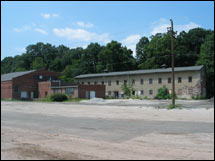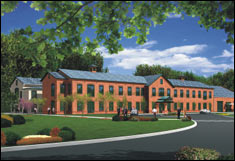BEND, Ore. (CNN/Money) – Until recently, most people who drove by the Betzwood Industrial Park near Valley Forge, Penn., saw a derelict paper plant with broken windows, smokestacks and old holding tanks.
 |
|
| The Lubin film studios at Betzwood Industrial Park before renovation. |
Real estate developer Brian O'Neill, however, saw dream homes.
To him, eyesore Betzwood was a prime property, with an ideal location along Schuylkill River and some historical significance to boot. The country's first movie studio is on the site, with the original buildings intact.
So his firm, O'Neill Properties, bought the industrial park, demolished many of the buildings and eliminated the environmental contaminants. "We try to save the historically significant buildings and scrap the ones that pose health hazards," said O'Neill, who made sure the movie studio buildings were preserved in the process.
Now, the place has become Riverview at Valley Forge, which will soon be home to quaint shops, outdoor cafes, and more than 2,000 luxury condos, townhouses and loft-like apartments.
Brownfields at a discount
Throughout the United States, developers like O'Neill are buying old factories, military bases, dumps and other so-called "brownfield" sites at huge discounts and giving them their own kind of extreme makeover.
 |
|
| The Lubin film studios at Riverview after renovation. |
In midtown Atlanta, an old steel mill is being transformed into a billion-dollar mixed-use (residential, office, retail) development called Atlantic Station. What was once the Stapleton Airport near downtown Denver, in its fourth year of construction, has about 3,000 residents and expects that number to reach 30,000 by the time its "urban village" is complete.
In Dallas, the site of a city dump, power plant and railroad maintenance facility is now in the early stages of redevelopment into "Victory," an upscale neighborhood of martini bars, shops, condos and boutique hotels.
"Over the past few years we've seen a corporate selling spree (of industrial real estate) such like we've never seen before," said O'Neill, whose firm boasts the largest privately held portfolio of brownfield sites.
Because old neighborhoods were built around factories, he said, these sites are often in central locations that have been fully developed – with the exception of the remaining factory, or warehouse or landfill.
That's a lot of untapped real estate. The Environmental Protection Agency (EPA) estimates that there are anywhere from 500,000 to a million brownfields in America, primarily in urban areas.
"This is a key component to what we call smart growth," said John McIllwain, senior resident fellow at the Urban Land Institute, referring to the redevelopment of brownfields in populated areas. "It's big."
Prime real estate, but is it safe?
Back in the 1950s, the city of Niagara Falls, N.Y., might have been thinking about smart growth when it paid $1 for 15 acres of land on the site of a chemical landfill.
The neighborhood of the Love Canal eventually grew to about 1,000 homes and apartments and three schools. But in 1978, the health hazards of living on a toxic dump started bubbling to the surface, quite literally.
When residents -- who had been complaining about smelly substances in their yards for years -- demanded that the city test the soil and air near their homes, toxic chemicals were found, and more than 200 homes were permanently evacuated.
After Love Canal became synonymous with "man-made disaster," developers and banks steered clear of any site that was contaminated or perceived as being contaminated, according to McIllwain.
"To a certain extent, the legal liability fell on anyone who owned the land," he said. Because banks could be held liable as well, such projects were virtually impossible to finance.
Throughout the 1970s, 1980s, and early 1990s, almost all such properties lay fallow.
Then, in 1995 the Environmental Protection Agency (EPA) launched an initiative to promote the safe redevelopment of brownfields with advice and funding to local governments willing to oversee such projects.
Today, all 50 states have some form of a volunteer remediation program under which developers can clean up a property and get the state's stamp of approval that it is safe. As of 2002, moreover, developers and other innocent landowners have liability protection if, despite their best efforts, contaminants are found on their property.
"We're in 'toddlerhood' of brownfield redevelopment," said Linda Garczynski, the EPA's director of brownfield cleanup and redevelopment.
Yet, the question remains: Are these properties safe?
"Our sites are cleaner than farm land when they're completed," said O'Neill. "We don't cut corners."
Still, there's no way of know whether any property is completely safe, said McIllwain. This is true of a brownfield and most any piece of land. One could argue that someone developing a brownfield knows more about potential safety hazards than someone developing a vacant plot of land.
| More on Your Home
|

|
|
|
|
If you're looking to move into a landfill turned luxury development, your best bet is to make sure the developers worked with your state to ensure that the soil, air and water is safe, noted Garczynski.
"You can have a high level of confidence that if [a developer] went through the state brownfield program, its safety has been overseen," she said.

|

